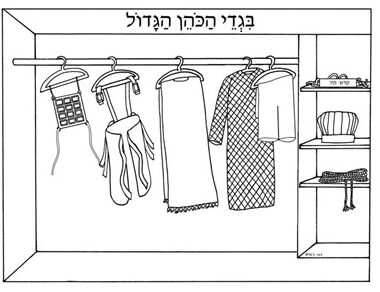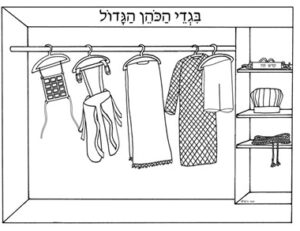
21 Apr Acharei – Kedoshim; The Garments of the Kohen Gadol and The Convert
 The Garments of the Kohen Gadol and The Convert; Acharei – Kedoshim
The Garments of the Kohen Gadol and The Convert; Acharei – Kedoshim
by Leib Getzel (Lawrence) Lax
Inspired by the teaching of HaRav Yitzchak Ginsburgh and Rabbi Moshe Genuth
The Parshas Acharei-Kedoshim often read together, speaks of the garments of the Koheb Gadol, The High Priest and the garments he must wear to enter the Holy of Holies.
The Kohen Gadol (amongst his garments) wears 4- white garments as a tikun (rectification) of sexual impropriety, and 4- gold garments as a tikun of idolatry. According to Chassidut, only the white garments are worn in the Holy of Holies.
The purpose of the tikun of these garments is that as the Kohen Gadol comes close to Hashem in His Inner Chamber (‘His Bedroom’) as a bride and groom , the Kohen Gadol (as the ‘bride’ possesing the feminine attribute ‘to receive’) must have acquired, hold and represent a level of purity to be able to receive Hashem’s powerful light and not die in the process of this intimate experience with the Almighty.
As it has also been repeated in parshas Acharei , Nadav and Avihu, the sons of Aron in their zeal brought an unasked for aka ‘foreign offering’ (as it was never commanded to bring) to Hashem . It is noted that there is a controversy whether or not their judgment was compromised by having been intoxicated or their intoxicated state was a stated reached through wine and spiritual intoxication. Due to the potential misuse of drunkenness, a law prohibiting intoxication was given accordingly. Although we learn from their actions that we should serve Hashem with great enthusiasm, we also are aware that there actions caused Hashem to take them from this world on the spot. The manner in which they were taken could be understood as meritorious to their lofty service to Hashem (there are many discussion on this).
The process of conversion may be considered as a process of acquiring the mitzvot, sometimes referred to as the spiritual garments of a Jew. Whether a Jew, non Jew or potential convert, we must be mindful in the pursuit of a closer relationship with Hashem to not add more light into a vessel as that can cause the vessel to become damaged or broken. For the person converting, this means that they should have a Rabbi (and a teacher) that will guide them to acquiring a rectified connection to Hashem in a way that their vessel receives Hashem’s Light, the Light of Torah in a healthy and rectified way.
Communities receiving conversion candidates (‘ger candidates’) should be aware of what is and is not appropriate when it comes to the acceptable spiritual Light (mitzvot, laws or blessings ) that may be learned by a person in who is a Jew, non Jew or authentic conversion candidate. The guidance of an Orthodox Rabbi is essential.
Regarding meeting a person who may claim to be a convert candidate it might help us how to know if that person is sincere in his/her desire to convert;
Have they been received by the Beit Din and been accepted to learn for the purpose of conversion?
Have they gotten a sponsoring Rabbi and conversion teacher?
As an approved candidate by the Beit Din are they learning regularly and in regular contact with their Rabbi?
Are they ‘mindful’ of Torah values?
To be a Jew, to learn Torah , and have Shabbos and Chagim is likened to having access and being in the Inner chamber of Hashem’s most intimate space, like a bride and groom. It can be shared in an appropriate way, but must also be guarded. Accordingly, we should speak to an Orthodox Rabbi to know what is and is not appropriate when reaching out.
Accepting a non-Jew into a Jewish community has many sensitivities for the Jewish Community and the Ger Candidate. It is important to know that the vessel or soul of a non Jew in transition to acquiring a righteous Jewish connection is going through a great transformation; body, mind and soul. The ger candidate is acquiring and integrating Hashem’s Light and His Torah. It is a most sensitive time for that neshsama(soul). And so it is a necessary that the person , the teachers and the community be mindful of the transformation of coming closer to Hashem, His Light, to ensure the light doesn’t break the vessel.
It is said that the Israelites survived the oppression of Egypt by maintaining three things; Names, Language and Garments. Deeper insight reveals that the garments they were wearing was the mitzvah of the prohibition of sexual immorality. While all of Egypt was sexually corrupt, the Israelites did not participate in this transgression. One example of the power of the Light of G-d’s mitzvot… as a ‘spiritual garment’ that merited the Redemption from Egypt.
As we learn from the Kohen Gadol and his garments as he enters the inner chamber with Hashem, we must learn that Torah and Mitzvot also create spiritual garments. We must aim to be ‘well dressed in mitzvot’ to appropriately receive Hashem, and help our fellow accordingly.
Leib Getzel (Lawrence) Lax
Addiction and Counseling (Hnrs)
http://lawrencelax.com
http://auraoftorah.com